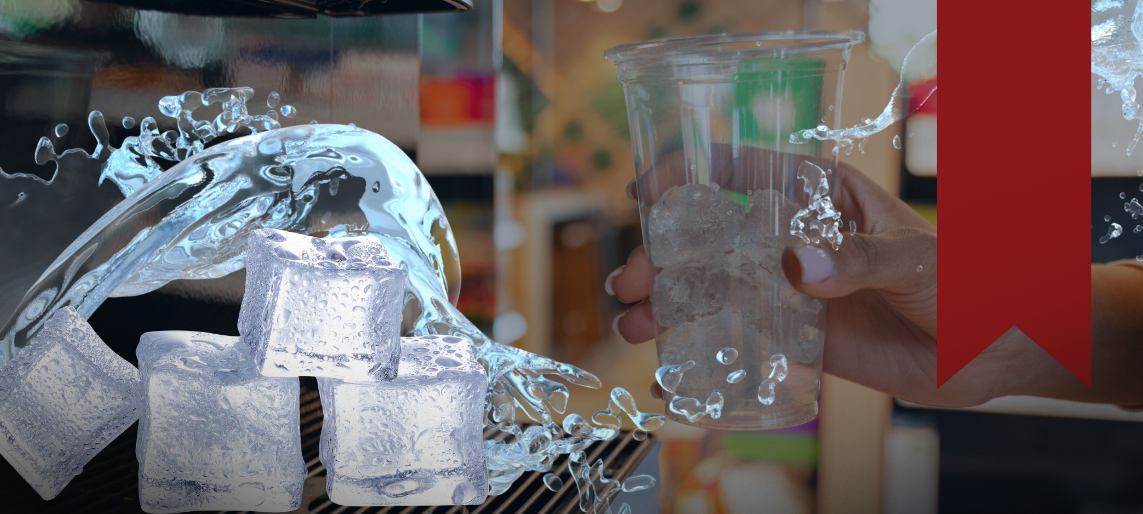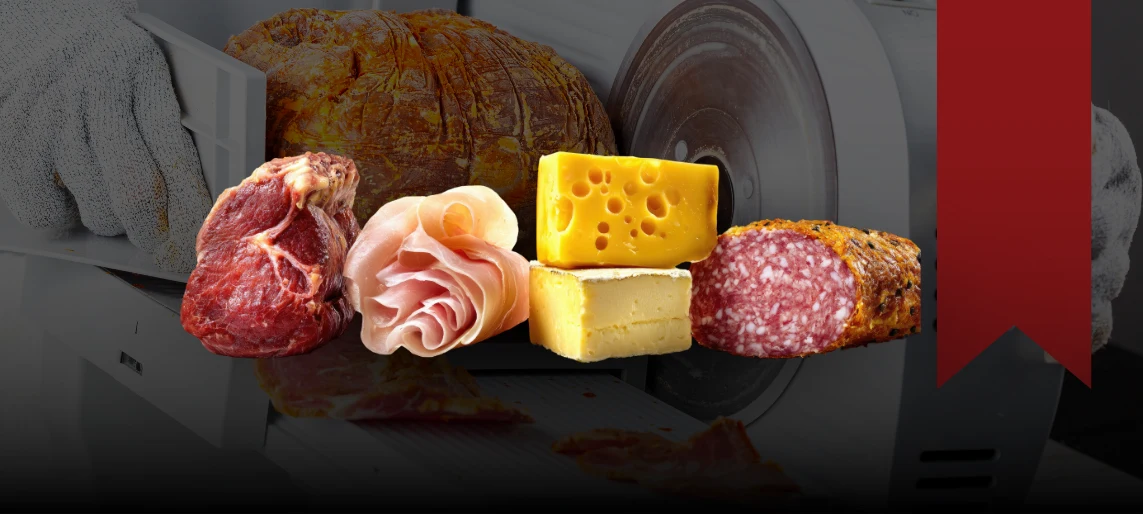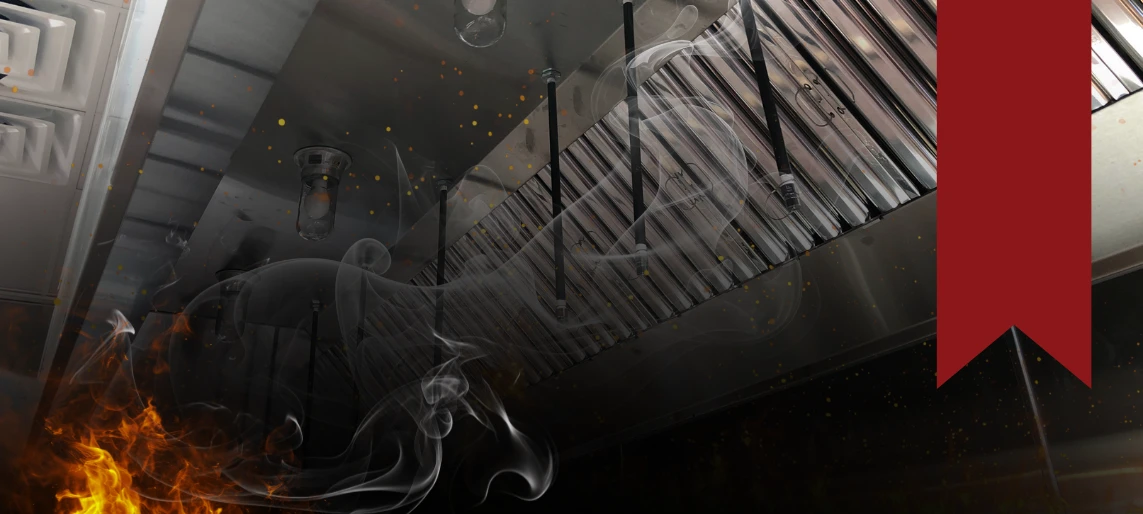
Summary
Buying an ice and water dispenser for a commercial kitchen, healthcare facility, or cafeteria seems simple — but there are hidden requirements. Learn about drain lines, water supply, filtration, air gaps, lever vs. sensor dispensing, air- vs. water-cooled systems, countertop vs. freestanding models, bin size, ice production, ice types, electrical needs, cleaning, clogged drain prevention, accessories, supplies, codes, and whether to choose ice-only or ice + water models.
The Appeal of Ice and Water Dispensers
An ice machine that dispenses both water and ice seems like a smart upgrade — especially in hospitals, cafeterias, and office settings. One unit saves space, provides convenience, and improves sanitation by reducing scooping.
But these machines have requirements and design choices that can easily be overlooked. If you don’t plan ahead, you’ll end up with leaks, code violations, or frustrated users.
What You Haven’t Thought About
Drain Lines
Every ice machine needs somewhere for meltwater to go. Without a proper drain line, you’ll have puddles and potential water damage. Consider:
- Type: Gravity drain (needs a nearby floor drain) vs. pump drain (for locations without floor drains).
- Slope: At least ¼” per foot toward the drain.
- Access: Is there a floor sink or floor drain within reach?
Water Supply
- Ice machines need a dedicated cold-water line with adequate pressure.
- Check local plumbing code for backflow prevention requirements.
Water Filtration
An ice and water dispenser is only as good as the water supply feeding it. Without proper filtration, you risk:
- Scale buildup that clogs lines and reduces efficiency
- Bad-tasting or cloudy ice that customers complain about
- Increased maintenance calls and shorter machine life
- Higher risk of pathogen growth in the water and ice supply
Types of Filters Commonly Used:
- Sediment Filters – Trap dirt, sand, and rust particles.
- Carbon Filters – Remove chlorine, odors, and bad tastes.
- Scale Inhibitors – Prevent lime and mineral buildup.
- Combination Cartridges – Many systems combine these in one cartridge.
- Bacterial-Retentive Filters – Physically block bacteria (≤0.2 micron), crucial in healthcare.
Preventing Legionella and Other Pathogens
- Legionella thrives in stagnant water and has caused outbreaks in hospitals.
- Proper filtration + cleaning = key defenses.
- Some facilities add UV disinfection or silver media for added protection.
Replacement Frequency:
- Every 6 months for most filters; more often in poor water conditions.
- Bacterial-retentive filters may require quarterly replacement in high-risk facilities.
📌 Pro Tip from Aldevra: In healthcare and high-sensitivity environments, specify NSF-certified bacterial-retentive filters and make filter changes part of your infection control plan.
Air Gaps
If your machine drains into a floor sink, most plumbing codes require an air gap — a space between the drain line and the wastewater surface.
- Must be at least twice the drain line diameter, and no less than 1 inch.
- Prevents backflow contamination.
- Too large a gap can cause splashing — a funnel floor sink may be needed.
📌 Pro Tip from Aldevra: Inspectors love to cite missing or undersized air gaps. Don’t get caught.
Lever vs. Sensor Dispensing
- Lever-activated: Simple, reliable, but higher-touch (germ transfer).
- Sensor-activated: Touch-free, hygienic, but more complex and power-dependent.
Air-Cooled vs. Water-Cooled
- Air-Cooled: Easier to install, lower cost, but needs ventilation clearance.
- Water-Cooled: Quieter, efficient in hot rooms, but higher water use (sometimes restricted).
Countertop vs. Freestanding Models
Choosing between a countertop or freestanding dispenser affects installation, space planning, and cost.
Countertop Models
- Pros:
- Space-saving — fit on existing counters or work tables.
- Great for breakrooms, nurses’ stations, and small cafeterias.
- Easy install when a drain or sink is nearby.
- Cons:
- Require sturdy counters with enough depth and weight capacity.
- Smaller bin capacity than freestanding units.
- May need a floor stand accessory if no counter is available.
Freestanding Models
- Pros:
- Self-contained — no counter required.
- Larger bins and higher production capacity.
- Ideal for dining halls, cafeterias, and high-traffic spaces.
- Cons:
- Take up more floor space.
- Higher upfront cost.
- Usually require legs or casters for cleaning/code compliance.
📌 Pro Tip from Aldevra: Countertop works best for quick access (like healthcare). Freestanding is better for shared spaces and higher volume.
Ice and Water vs. Ice Only Dispensers
Should you choose ice + water or ice only?
- Ice + Water Dispensers
- Save space and offer all-in-one convenience.
- Common in healthcare and offices.
- More plumbing + higher upfront cost.
- Ice Only Dispensers
- Lower cost, fewer parts to maintain.
- Better for kitchens and cafeterias where water is available elsewhere.
📌 Pro Tip from Aldevra: Match the dispenser type to how users will interact with it daily.
Bin Size (Storage Capacity)
The bin tells you how much ice is ready now.
- Too small = runouts during rushes.
- Too large = wasted energy or stale ice.
- Add 20–30% buffer above peak usage.
Ice Production (Daily Capacity)
Production is measured over 24 hours.
- Small units: 100–200 lbs/day
- Mid-size: 300–500 lbs/day
- Large: 700+ lbs/day
📌 Example: A “25 lb” machine may only store 25 lbs, but still produce 300 lbs/day. Great for steady use — not for rushes.
Ice Type Preference
- Full Cube: Slow melt, best for dining.
- Half Cube: Faster cooling, versatile.
- Nugget: Chewable, healthcare favorite.
- Flake: Displays and therapeutic use.
Electrical Requirements
- 115V Units: Easy install, best for light/medium use.
- 208–230V Units: Required for larger machines; handle heavy demand more efficiently.
📌 Pro Tip from Aldevra: Always verify electrical panels before purchase. Upgrades often cost more than the machine itself.
Ventilation & Space
Air-cooled units must breathe. Without clearance, machines overheat and fail early. Always measure service space.
Maintenance & Cleaning
Ice machines are food equipment — they must be cleaned like any food-contact surface.
- Every 6 months minimum (2–3 months in healthcare).
- Clean bins, sanitize surfaces, flush drains, and replace filters.
- Watch for clogged drains from scale, slime, or poor slope.
- Use enzyme-based drain cleaners or brushes for prevention.
📌 Pro Tip from Aldevra: Preventive maintenance saves money. Emergency service for clogs and contamination costs far more.
Common Accessories Purchased with Ice and Water Dispensers
Many buyers also need:
- 6″ Adjustable Legs – Required by health codes in foodservice.
- Caster Kits – For mobility in kitchens with daily floor cleaning.
- Drain Pumps – If no nearby floor drain.
- Floor Stands / Cabinets – Convert countertop units to freestanding.
- Splash Guards – Protect nearby walls/floors.
- Water Chillers – Optional add-ons to keep dispensed water colder.
Common Supplies Used with Ice and Water Dispensers
Ongoing supplies are essential for sanitation and uptime:
- Cleaning Solution – Removes scale/mineral buildup.
- Food-Safe Sanitizer – For bins and dispensers.
- Enzyme Drain Cleaners – Prevent clogs.
- Filter Cartridges – Sediment, carbon, scale, bacterial-retentive.
- Replacement Gaskets – For doors and bins.
- Brush Kits – For drain lines and water tubes.
- Gloves & PPE – For safe chemical handling.
Codes and Standards to Know
Inspectors check installations against national codes — and local amendments may be stricter.
- Plumbing Codes: IPC & UPC – Require slope, drains, air gaps.
- Food Safety Codes: FDA Food Code (ice = food); NSF/ANSI 12 (ice machine standard); NSF 53 & 58 (filtration).
- Health Guidance: CDC – Prevent Legionella through maintenance and filtration.
- Electrical Codes: NEC / NFPA 70 – Governs outlets and circuits.
📌 Pro Tip from Aldevra: Always confirm with your local AHJ. Passing federal code doesn’t guarantee passing local inspection.
Quick Buyer’s Checklist: Ice & Water Dispensers
Before You Buy
- ☐ Floor drain nearby (or pump drain planned)
- ☐ Drain line sloped ¼” per foot and clog-free
- ☐ Air gap sized correctly (2x drain diameter, min. 1″)
- ☐ Dedicated cold-water line with proper pressure
- ☐ Filter installed (sediment, carbon, scale, bacterial-retentive in healthcare)
Dispenser Configuration
- ☐ Countertop (space-saving, smaller bin)
- ☐ Freestanding (larger bin, higher volume)
- ☐ Ice + water combo (all-in-one convenience)
- ☐ Ice only (lower cost, simpler maintenance)
Dispensing Options
- ☐ Lever-activated (simple, reliable)
- ☐ Sensor-activated (touch-free, hygienic)
Cooling Method
- ☐ Air-cooled (lower cost, needs ventilation)
- ☐ Water-cooled (quiet, efficient, higher water use)
Capacity & Ice Type
- ☐ Bin size matches peak demand (+20–30% buffer)
- ☐ Production meets daily demand
- ☐ Ice type suits users (cube, half cube, nugget, flake)
Electrical & Space
- ☐ Circuit matches unit (115V or 208–230V)
- ☐ Clearance for ventilation and service access
- ☐ Noise level acceptable for location
Accessories
- ☐ Adjustable legs or casters for code compliance & cleaning access
- ☐ Drain pump if no floor drain nearby
- ☐ Floor stand or cabinet (if countertop unit)
- ☐ Splash guard to protect walls/floors
Supplies & Maintenance
- ☐ Cleaning solution for descaling
- ☐ Food-safe sanitizer for bin & dispenser
- ☐ Enzyme drain cleaner or brushes to prevent clogs
- ☐ Filter replacement plan (every 6 months or sooner)
- ☐ Spare gaskets and parts stocked
- ☐ PPE (gloves, eyewear) for safe cleaning
Budgeting
- ☐ Installation budget includes plumbing, drains, electrical upgrades if needed
- ☐ Preventive maintenance (filters, supplies, service) factored into operating costs
FAQs About Ice and Water Dispensers
Q: Can I install an ice and water dispenser without a floor drain?
A: Yes, but you’ll need a drain pump. Pumps require regular cleaning and can fail if neglected.
Q: Which is better: countertop or freestanding models?
A: Countertop saves space and is perfect for breakrooms or nurses’ stations. Freestanding handles higher volumes and is better for cafeterias, lobbies, or large shared spaces.
Q: Should I choose an ice + water dispenser or ice only?
A: Ice + water units are more convenient in healthcare and offices. Ice-only units are simpler, lower cost, and best where water is already provided.
Q: Which dispensing option is more hygienic: lever or sensor?
A: Sensor-activated models are touch-free and more hygienic. Lever models are simpler and often cheaper.
Q: Do I need a water filter?
A: Yes. Filters improve ice quality, extend machine life, and reduce bacteria risk. In healthcare, use bacterial-retentive filters.
Q: How often should the machine be cleaned?
A: At least every 6 months — or every 2–3 months in healthcare or high-use settings.
Q: What accessories might I need?
A: Legs or casters, drain pumps, splash guards, and floor stands are common.
Q: What supplies should I keep on hand?
A: Cleaning solution, sanitizer, enzyme drain cleaner, replacement filters, spare gaskets, and PPE.
Q: How do I size the dispenser correctly?
A: Choose a bin 20–30% larger than your peak demand, then confirm daily production meets total demand.
Q: What codes apply?
A: IPC/UPC plumbing codes, NSF/ANSI standards, FDA Food Code, and NEC electrical code apply. Always confirm with your local inspector.
✅ Bottom line
An ice and water dispenser is a smart upgrade, but success depends on proper planning for drains, water, filtration, air gaps, bin size, production, ice type, power, accessories, supplies, codes, and cleaning.











